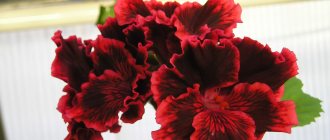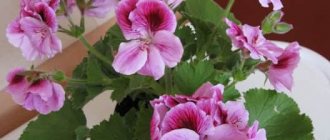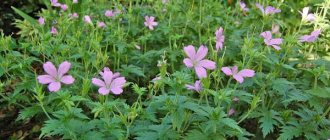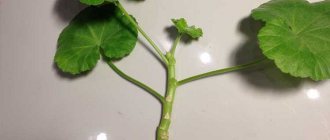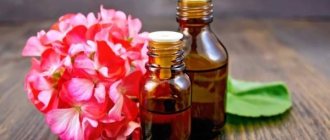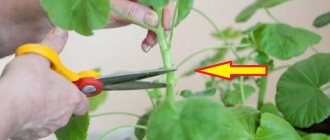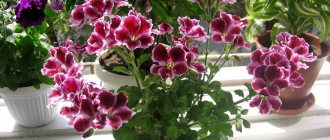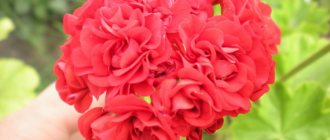This beautiful and unpretentious indoor, and if desired, garden plant with fragrant feathery or rounded leaves, with clusters of red or pink flowers, was loved by our great-grandmothers. We are, of course, talking about geranium, which is now more often called pelargonium. Previously, it was believed that this flower rarely got sick, and they didn’t bother with its treatment: after all, it’s very easy to grow a new bush from a cutting. Now pelargonists are actively discussing diseases and methods of treating their favorite plant at home, and everyone has a “green first aid kit.” What and why can indoor pelargonium be sick and how to help it?
Home conditions for pelargonium
Pelargonium (aka geranium), which is grown on windowsills, is a native of the South African savannas. And like all Africans, she loves the sun and warmth very much, but has a negative attitude towards soil that is too nutritious and too wet. Rain is rare in the savannah, and the land there is poor.
Pelargonium is a true African, it loves the sun, warmth and can tolerate a slight drought
In indoor floriculture, three types of pelargonium are known: zonal, royal (or royal) and ampelous. It is the zonal, or garden, geraniums that are planted in flower beds in the spring. They bloom for a very long time and reproduce without problems from cuttings. Royal pelargoniums are more whimsical. Their flowers are larger and more interesting than those of the zonal ones, but the flowering period is shorter and they are more difficult to reproduce. Ampelous geraniums are the most delicate and complex. But in general, pelargoniums are not very demanding and grateful flowers.
The strongest pelargoniums are zonal, royal and ampelous varieties, which are more delicate
The characteristics of flowering southerners must be taken into account when growing them at home. Place pelargonium window sills on the south, east or west side. Plant it in a cramped pot so that it blooms better, give it not very nutritious soil with a good drainage layer.
Pelargonium grows well on the sunny side, and a small pot stimulates flowering
Water rarely, but a lot, when it grows and blooms. But do not allow water to stagnate, remove excess water from the pan. In winter, only lightly moisten the soil; it should have time to dry out between waterings. There is no need to spray pelargonium; in nature it is not spoiled by high humidity. On the contrary, pubescent leaves can get sick if drops get on them. Be careful with fertilizing. Pelargonium can get sick from both lack of nutrition and excess. So keep your balance.
During flowering, pelergonium needs abundant watering and feeding, but during dormancy, excess moisture and nutrition can lead to disease.
Blooming geranium needs fresh air all year round; ventilate the room where it grows. This is a good prevention of fungal diseases. In the summer, give the flower walks: put it in the fresh air or even plant it in open ground. The geranium will literally bloom there. In the fall, bring the whole plant or its cuttings home again.
Organize cool wintering, optimally from +10 to +15 degrees. And in winter, just as in summer, pelargonium needs plenty of light. If there is a deficiency, the leaves will be small, and flowering will be sparse or buds will not form at all. If there is not enough sun, artificial lighting (phytolamps, fluorescent or LED) will help.
Indoor geranium responds well to pinching and pruning. Form a fluffy bush in spring and summer, trim pelargonium for rejuvenation. And be sure to remove faded flower stalks so that new ones appear.
Pelargonium needs good lighting all year round; without this it will not bloom, and may even get sick.
But don’t rush to transplant pelargonium from pot to pot. This plant is not prone to changing places. After relocation, she may turn yellow and become depressed so that resuscitation is required.
What is the difference between geranium and pelargonium ivy-leaved
Shield geranium, or as it is also called ampelous ivy-leaved pelargonium, is ideal for forming a hanging garden, decorating a balcony, terrace, window or veranda. Many people believe that geranium and pelargonium are the same plant. But this is not so, although they belong to the same Geraniev family. Outwardly, these two sisters are not alike. So what is the difference between Geranium and Pelargonium?
The difference between geranium and pelargonium
The main difference between these two plants is the leaves and flowers, but their seed pods are identical. If you see bright red, pink or white umbrellas in front of your eyes, this is pelargonium. These two plants were confused back in the 18th century. scientists, but there is a difference in caring for them. It is very important to know the differences in order to understand how to properly care for indoor pets.
Geranium comes in the following types:
- bordered (zonal);
- ivy-leaved;
- angel;
- fragrant;
- royal;
- garden unique;
- tulip-shaped;
- dwarf.
Note! In addition, the plant differs in the shape of the flower. There are rosaceous, cactus, zonal and carnation crops. Each type of geranium has a special beauty.
Why do pelargoniums start to get sick more often?
Once upon a time, flowering geraniums were considered very healthy plants and resistant to all sorts of ailments. Probably the fact is that flower growers did not even try to understand why the leaves suddenly turned yellow or red, and the buds and flowers withered. They simply broke off a branch and grew a new healthy plant, and threw away the old one. Now pelargonium has become more expensive, both figuratively and literally. Flower lovers become attached to their pets and do not want to lose them. And varietal types of pelargonium are not so little worth throwing at them.
Pelargonium lovers try to cure their delicate pets if they are sick
At the same time, with the development of home floriculture, plants developed diseases that our grandmothers, who grew geraniums on the windowsill, did not even suspect. Oddly enough, progress is to blame. New varieties of pelargonium are very decorative; they bloom more brightly. And at the same time, they are more delicate and more easily infected with fungal or viral infections, and suffer more from care errors and metabolic diseases. Plant immunity has become much weaker. And fungi, viruses and pests are hardened, they mutate, adapting to modern drugs, and increase resistance. So it turns out that pelargonium lovers are forced to acquire special medicines and reference books to treat their flowers. But it is not all that bad. Pelargonium, which has been created in optimal conditions and is adequately cared for, will be healthy and certainly bloom.
Pelargonium will bloom with proper care
Video: all about the problems of caring for geraniums
Insect pests and measures to combat them
If not properly cared for, geranium weakens and is easily exposed to various parasites. To prevent this, you need to know which insects can destroy a plant and how to deal with them.
Whitefly
Very dangerous for geraniums are small white midges called whiteflies. Insects live on the lower part of the leaf. If you detect uninvited guests, you need to take immediate action:
- The first step is to remove the leaves on which the largest number of parasites are located.
- The next step is treatment with an insecticide. Treatment is carried out three times with an interval of 7 days. You can use Aktara or Confidor. If you chose the second product, then you should know that it has a pungent odor. In order not to harm your health, it is better to carry out the treatment outdoors or in a well-ventilated area.
Aphid
The leaves of the flower began to curl - perhaps this is the work of aphids. These are pests. Which feed on plant sap, causing them to become lethargic and weak. The leaves on which aphids live curl and dry out very quickly.
Aphids are insects that reproduce very quickly. If action is not taken immediately, then within a few days these parasites can infest the entire plant. Which will ultimately lead to his death.
To get rid of aphids, you need to remove the parts of the plant on which the insects live and treat it with Fitoverm or Mospilan.
Spider mite
Spider mites are very easy to spot. If cobwebs and white dots on the leaves appear on the plant, then this is certainly the work of a spider mite. Under the influence of the parasite, the leaves begin to curl inward.
The best conditions for tick reproduction are dry air. The danger of such a resident is that he is capable of transmitting infectious diseases.
To get rid of the uninvited guest, you need to remove the parts on which it lives and treat the plant with an insecticide.
Termites
- To destroy termites, you can use chemicals, for example, Messenger or Marathon. They are also used to prevent the appearance of these parasites.
- You can also spray with aspirin solution. To prepare the solution, you need to dissolve one tablet in eight liters of water.
Nematodes
They are the smallest and most dangerous worms . They destroy the plant from the inside by eating its roots.
As a result, nodules appear on the rhizomes due to exposure. Unfortunately there is no treatment.
A plant infected with nematodes must be destroyed.
Root mealybug
The ideal habitat is waterlogged soil. The root bug feeds on the roots, which leads to a stop in the development of geraniums.
- In case of minor infection, it is enough to wash the roots and remove the damaged parts.
- Next, the plant is transplanted into new soil, which is pre-treated with an insecticidal agent.
- Watering with Aktara will be useful.
In case of serious infestations, the plants cannot be saved.
We invite you to watch a video about geranium pests:
Diseases and pests of pelargonium
Diseases of pelargonium can be divided into two large groups: non-infectious and infectious. Non-infectious diseases cause violations of the rules of care and metabolic processes of the plant. These are hypothermia, swelling, deficiency or excess of microelements, a reaction to chemicals. Infectious diseases are the result of infection by a fungus, bacteria or virus; these are various rots, spots, rust, powdery mildew, and blackleg. Such diseases are dangerous because they are easily transmitted from flower to flower. Therefore, when an infection is detected, it is necessary to urgently take quarantine measures to prevent infection and epidemics.
A plant with an infectious disease must be isolated, otherwise the entire collection will become infected
Pests are not too fond of pelargonium. For example, a punishment for flower growers - spider mites or scale insects rarely attack geraniums. Perhaps the specific aroma of the essential oil contained in the foliage of most plant species repels insects. But whiteflies, aphids, mealybugs and rootbugs are not bothered by this feature. And in the summer, when kept outside, geraniums are attacked by caterpillars.
Pests of ivy-leaved pelargonium
Pests of indoor plants and diseases of indoor flowers
In addition to diseases, the plant is affected by pests:
- spider mite Yellow dots appear on the leaves, after which they dry out;
- caterpillars. Holes appear in the leaves;
- whitefly Eggs are laid on the leaves and begin to curl;
- aphid. Leaves die and dry out;
- nematode. Insects feed on the rhizomes of the plant;
- thrips. Growths form on the reverse side of the leaf, after which the greenery turns white.
Important! All pests can be effectively controlled using insecticides.
Phytocontrol measures
It is easier to prevent a disease than to cure it; this principle of prevention also applies to plants. And her main rule is hygiene. A plant free from diseases and parasites and clean soil will be the key to healthy pelargonium. A flower can pick up an infection or parasite anywhere: in a nursery, in a store, in the soil. To protect your green pets, introduce home phytosanitary control. These measures will ensure the safety of the plants.
- Make sure the new plant is not infected with disease or parasites. Before bringing it home, inspect the stems and leaves, and, if possible, the roots. If there are spots, dots, other damage or symptoms of disease, you should be wary. Inspect geraniums for insect pests. An innocent white speck may turn out to be a mealybug. If the damage is severe, it is better to abandon the plant; it can infect others. And such an acquisition will bring more trouble than pleasure.
- The new plant, at first glance, is completely healthy. Don’t be complacent about this and don’t rush to add him to the other green pets. Health problems may appear later. Fungal and viral diseases have an incubation period during which symptoms do not appear. And pests whose adults have been destroyed can leave behind larvae. Keep the new flower in isolation for at least two weeks, and preferably at least a month. Only after quarantine introduce him to the rest of your windowsill neighbors.
- Be careful when replanting pelargoniums. She doesn't like this procedure anyway. Additionally, most bacteria, fungi and parasites are spread through soil. And store-bought soil is no exception. It may contain not only useful components, but also fungal spores. Before planting, be sure to disinfect the substrate and drainage by heating, and pour boiling water over the pot. You can also water the new soil with a solution of some fungicide.
An infection or pest can enter the house from the greenhouse, so keep new plants in quarantine
Video: inspection of new plants and preventive treatment
Fighting scale insects: step-by-step instructions
The fight against scale insects on plants includes several stages, and the control measures for different species are identical. The first stage is the cleansing and elimination of fallen leaves and shoots. The second is treatment with chemical means of destruction. The third is re-treatment and prevention.
Mechanical control measures
- Damaged leaves and shoots are removed. If the leaf cannot be cut without causing particularly traumatic damage, it is cleaned of plaque and pests with a cotton pad soaked in insecticide.
- If that doesn’t work, do it in a soapy solution.
- In difficult cases, you can scrape off an inch from the hard leaves of the plant with the back of a knife.
- Plants that can be exposed to water are sent to the shower: the leaves are washed with lukewarm water and a mild alcohol soap solution (from 1:10).
- Those whose leaves cannot be wetted are wiped with a swab or cloth.
- Change the substrate or its upper part.
- After cleaning, the flower is dried and treated with an insecticide. It is important to treat the top layer of soil.
Remedies for scale insects on indoor plants
It’s not easy to find funds. The difficulty is in overcoming the protective barrier of wax, which saves the insect from drugs that destroy the chitin layer.
This is why contact insecticides are practically ineffective.
It would be rational to use systemic, intestinal insecticides, the action of which is nerve-paralytic or is aimed at poisoning the pest from the inside.
Systemic insecticides based on imidaclpride (cypermethrin, finpronil), aversectin C, etc. are used against scale insects in the house.
- Organophosphorus compounds (FOS): Iskra, Karbofos, Kemifos, Antiklesch, Aktellik, Altar.
- Neonicotinoids: Mospilan, Kofidor, Iskra Zolotaya, Aktara, Apache, Tanrek, Colorado.
- Juvenoids, hormonal insecticides: Admiral, etc.
Preparations for scale insects in the apartment
A review of anti-scale insecticides that have proven effective according to flower growers - effective, economical, proven.
Symptoms and diagnoses (table)
| Manifestation of the problem | Care error | Disease | Pest |
| Pelargonium leaves turn yellow and fall off. | Too warm air, excessive watering or draft. | Root rot in the initial stage. Excess nitrogen in the soil. | If white fluffy lumps are visible in the sinuses, it is a mealybug. |
| The lower leaves turn yellow and the edges dry out. | Old leaves die over time, this is a natural phenomenon. | Nutritional deficiency. | |
| There are wet areas on the stems, the leaves wither. | Stem rot. | ||
| Pelargonium does not form buds and turns yellow. | Very high temperature, high humidity. | Not enough nutrients. | |
| The plant has stopped growing, the leaves are limp even after watering. | The pot became too cramped. | Lack of nitrogen, low soil acidity. | Inspect the undersides of the leaves. It could be a whitefly or mealybug infestation. |
| There are brown-red spots on the foliage, the trunk also turns red. | Hypothermia or too much direct sun | ||
| Black dots on leaves. | Unbalanced watering, pelargonium is either dried or watered. | ||
| The leaves turn yellow in the center, the edges remain green. | Magnesium chlorosis. | ||
| The edges of the leaves turn white, but do not dry out, and may be limp. | Nitrogen deficiency. | ||
| The stem darkens and rots from below. The leaves are withering. | Blackleg. | ||
| Leaves wither and droop like umbrellas | Soil drying out. | Fungal infection. | |
| There are swollen watery tubercles on the leaf blade. | Overwatering of the soil is sometimes combined with periods of dryness. | Edema (edema). | |
| Brown-gray spots on the leaves and stems of the plant, especially in the lower part. | Gray rot. | ||
| Pelargonium does not grow, turns yellow entirely, and fades. | Root rot in advanced form. | Root mealybug | |
| The stem stretches out unsightly. | Lack of light with short days. | Etiolation. | |
| The roots and lower part are covered with spots pressed inward. The spotting quickly spreads upward. The plant withers if left untreated and dies. | Stem and root late blight. | ||
| On the upper side of the leaf blade there are light green blurry spots with brown dots in the center. They quickly increase in size and merge. | Rust. | ||
| Light spots with a ring pattern on the leaves. Later they become deformed. The plant does not develop and does not bloom. | Ring spot. | ||
| There is a whitish coating on the leaves. | Powdery mildew. | ||
| Yellowing of leaves along the veins. | Tobacco or tomato viruses. | ||
| The leaves have holes of different sizes. | Caterpillar attack. | ||
| Young shoots, leaves, buds curl and die. | Aphid infestation. | ||
| A net forms on the leaves, with a green pattern along the veins and yellow spots between them. | Manganese deficiency. | ||
| The leaves lose color and turn pale. | Chlorosis, iron deficiency. | ||
| The leaves become very dry at the edges and curl. | Bacterial burn. | ||
| The edges of the leaves turn brown and dry out. | Reaction to a low-quality fungicide or its excess. | Excess phosphorus. | |
| The leaves are green, but curled up. | Reaction to watering with herbicide. | ||
| The leaves die, there are greenish larvae on the underside, and flying insects around. | Whitefly infestation. |
Gray rot
Brown spots appear on areas of plants located above the ground and spread quickly. In this case, the plant does not bloom, the leaves turn yellow and dry. Leaves that are closer to the ground are the first to be affected. Some varieties are beginning to show spotting. With high humidity, areas of the flower that are damaged by the disease begin to become covered with a gray coating of the fungus, which has a dense structure. This disease makes it difficult to grow beautiful pelargonium at home.
Why does the disease develop? The spread of the disease is accompanied by improper care - waterlogging of the substrate, insufficient ventilation, excessive spraying, increased nitrogen content in the soil.
What to do if the first manifestations of the disease appear? It is necessary to treat the flower with systemic fungicides (Vitaros, Fundazol, etc.). In this way, you can not only protect the plant, but also make it bloom.
Geranium diseases, treatment and prevention
Pelargoniums most often get sick due to waterlogging of the soil. It is the flooding of the plant that gives impetus to the development of various types of rot and spotting. The disease progresses especially quickly if the room is stale, stale air, too cold or, conversely, too hot. Pelargonium gets sick from a deficiency of microelements, but also from overfeeding. These problems weaken the immune system. As a result, the plant becomes more easily infected with fungal or viral infections.
Problems caused by metabolic disorders and care errors
Diseases related to care and metabolism are not contagious. Plants with etiolation, chlorosis, deficiency or excess of nutrients are not sent to quarantine. But these ailments cannot be left without treatment, because sooner or later they will lead to more serious problems.
This pelargonium is suffering from care errors; the leaves have turned red either from hypothermia or from too much direct sun.
Etiolation is a disease of light deficiency. If pelargonium does not have enough light, it stretches unsightly, the leaves become smaller and lighter. Such a plant will not bloom. It is not difficult to cure: place the geranium on the sunny side, and in winter add artificial lighting. Just be careful, get used to bright light gradually so that there are no burns. In addition, for the harmonious formation of a flower, it is useful to turn it towards the light with different sides.
With a lack of light, the leaves become smaller and lighter, the stems elongate
Edema, or edema, mainly affects ivy-leaved pelargoniums, less often other species . The cause of the disease is non-drying soil combined with cold and humid air. The roots absorb water, but the leaves do not have time to evaporate it.
Too much watering and humid air lead to swelling of the leaves.
The tissue ruptures and watery pads form on the underside. Affected leaves die or lose their decorative properties. The pads enlarge and become coarser, acquiring a brownish color. Therapeutic measures include drying the soil, adjusting watering, and reducing air humidity. Prevention - good drainage and fresh air.
Magnesium deficiency causes leaves to turn yellow in the center.
Chlorosis is a disruption of the process of photosynthesis. Symptoms of the disease are changes in leaf color and slower growth. Usually, when talking about chlorosis, they mean iron deficiency. But in pelargoniums, the lack of other chemical elements also affects health and appearance. For example, a deficiency of magnesium causes yellowing of the center of the leaves, a lack of manganese causes a green mesh to appear along the veins with yellowness inside, the edges of the foliage turn white from a lack of nitrogen.
White edges of leaves are a lack of nitrogen
In all cases, there is only one solution - to choose a mineral complex containing the necessary components. For example, iron chelate (Antichlorosin) for deficiency of this element. Or a fertilizer balanced in composition.
Treatment of chlorosis is the selection of a nutritional complex with deficient elements or transplantation into fresh soil
Pelargonists note that the preparations Uniflor-Rost, Uniflor-micro, plant regenerator Pokon Green Power, Agricola Aqua for yellowing of leaves have proven themselves well.
But no less than a deficiency of nutrients, their excess is harmful for pelargonium. Too much nitrogen in the soil will cause the leaves to turn yellow; too much phosphorus will cause the edges to become brown and dry. Therefore, it is better to slightly underfeed the geranium.
Phosphorus is beneficial for plant flowering, but its excess is harmful to leaf health
Metabolic problems can also be solved by transplanting pelargonium. The right substrate should have everything you need for growth and health.
Geraniums find it difficult to take root in a new place. Immediately after transplantation, they need gentle care. Pelargonium is placed in a warm place. Shade from direct sun. Water moderately; unestablished roots easily rot. No spraying is necessary. You can add stimulants to irrigation water: epin or zircon.
Too concentrated a fungicide solution can harm pelargonium
Pelargonium can get sick after using herbicides or fungicides. The former are used to control weeds in open ground, the latter - to treat rot. In this case, transplantation or gentle transshipment will help. may have to get rid of the affected foliage, but it will grow back. The main thing is the condition of the root. If it is healthy, the plant can be treated.
Pelargonium treated with herbicide may lose all leaves
Infectious diseases
A fertile environment for the development of pathogens of infectious diseases is waterlogged and unsterilized soil. Various fungi, bacteria and viruses multiply there quickly. Pelargonium that has contracted an infection must be isolated. If a green patient is left among healthy people, everyone can become infected. Some infections are so fleeting and dangerous that immediate destruction of the diseased plant is required.
If you do not pay attention to pelargonium disease, it may die from infection.
Prevention of infectious diseases:
- attentive, without excess, watering;
- dry air, especially in a cool room;
- mandatory soil sterilization;
- pest control;
- quarantine for new plants.
How to feed and fertilize geraniums correctly
This crop rarely needs replanting and can grow in one pot for more than one year. Fertilizing is done with liquid universal fertilizer for flowering crops once every 2-3 weeks. The solution must be prepared according to the instructions on the package.
Geranium feeding technology:
- mineral fertilizers (potassium and phosphorus) are added 2 times a month. These microelements prolong flowering and strengthen the crop;
- watering with a heteroauxin solution or sweet water will help geraniums bloom in winter. An artificial or natural stimulant must be added weekly;
- ready-made complex fertilizer. Added according to instructions.
Note! Pelargonium “loves” natural fertilizer in the form of regular iodine in a proportion of 1 ml per 1 liter of warm water.
Feeding geraniums with iodine
The iodine solution is added as follows:
- the soil is watered;
- when the soil dries out a little, add iodine fertilizer (pour along the wall of the pot at a distance of at least half a centimeter from the plant).
There are some recommendations for feeding geraniums that will ensure the plant looks healthy and blooms profusely.
The feeding rules are as follows:
- If the crop has been exposed to improper lighting for a long time, it is not recommended to feed it. First you need to fix this error;
- if a plant is “diagnosed” with a disease or pests are found on it, then first you need to get rid of them, and only then feed them;
- after adding fertilizers, it is worth loosening the soil in the pot to ensure oxygen access to the roots;
- You cannot fertilize the crop more than once a week;
- for young flowers and in winter, the dose of bait should be halved.
Geranium is a universal beautiful flower that, with proper care, will delight you with lush inflorescences and a pleasant aroma. Now, knowing how to care for (geranium blooms better with proper care) this beautiful plant, there should be no problems with its cultivation.
Anthracnose pelargonium
Anthracnose is a fungal disease that appears as round or irregular leaf spots. Fungal spores appear as hairy, brownish-brown bumps. Pelargonium is affected by anthracnose slowly, therefore, having identified the first signs of the disease, you must immediately take measures to quickly get rid of it.
The first step is to immediately remove all damaged parts of the flower and cover the living tissues with crushed coal. Next, you should reduce the air humidity, due to which the intensive development of the disease occurs. To do this, you need to stop spraying the plant and drain excess water from the pan. It is also advisable to disinfect the soil.
The plant itself must be treated with fungicides or insecticides. A good result is achieved by using the drug Abiga-Peak (50 g per 10 l), copper sulfate (100 g per 10 l), Bordeaux mixture or colloidal sulfur. Typically, three times of treatment with fungicides is enough to get rid of the disease.
The necessary conditions
When growing ivy geraniums, the following conditions must be observed:
- Lighting . The plant actively blooms and develops in bright light. Thanks to this, you can install the pot anywhere, even in direct sunlight. But lack of light and drought harm the plant.
- Temperature . In summer, the room temperature must be maintained at a temperature of at least 25 degrees, and in winter – 15 degrees. And although the plant can easily tolerate drought, frost has a detrimental effect on it.
- Humidity . Too dry air is not harmful to geranium; it does not need additional moistening or spraying. The optimal humidity is 65-70%.
Why ampelous geranium does not bloom
With proper care, the buds of the crop bloom from spring to late autumn. Sometimes geraniums can bloom even in winter. If buds do not form on the plants, it means that the gardener is making some mistakes.
The most common mistakes when growing geraniums
Experts can explain why the ampelous geranium does not bloom. They note the following mistakes made by novice gardeners:
- too frequent or infrequent watering. As a result, the geranium weakens, does not form an ovary, and can be affected by diseases and pests;
- a small bush is planted in a large pot. Until the root system entwines the container, flowering will not occur. Therefore, you need to increase the size of the container gradually when transplanting;
- lack of nutrients in the soil. Monthly fertilizing will help the plants form flower ovaries;
- the bushes are in too dark a room. For abundant and long-lasting flowering, they need to be placed in a well-lit place.
Note! Pelargonium protects the home, so it is worth growing for those people who want to create an atmosphere of mutual understanding and respect.
If the plant is affected by a disease, you can take cuttings and grow new bushes
Leaf spotting and curling
The plant stops blooming. Small spots form on young foliage. As the disease progresses, chlorotic spots grow in size and become quite large. The center of the spot is pronounced and yellow in color, with rings of a lighter shade formed around it. Why do geranium leaves curl? This happens when the nutrition of the leaves is disrupted. The veins may become lighter and the edges of the leaves may dry out. Sometimes the virus appears as slightly transparent oily spots with a green center surrounded by yellow concentric rings.
The virus is contained in the infected plant. It is transmitted during the process of vegetative propagation, and is also carried by sucking insects (most often whiteflies) - which is why it is necessary to ensure that pests do not appear in home breeding conditions. The disease can be defeated by using healthy plants for propagation, as well as by timely treatment with insecticides.
By adhering to the advice of proper maintenance at home and quickly responding to the first signs of disease, using folk remedies and various drugs to combat diseases, your geranium will be beautiful and healthy and will begin to bloom profusely.
Rotting of the stem and roots of indoor geranium
A diseased geranium does not bloom, it rapidly withers and then finally dies. The roots and the root neck itself are covered with darkish spots that have a depressed structure. As the disease progresses, the affected areas of the plant begin to rot, and the diseased flower “lies down.” Also, fungal mycelium can often be seen on the affected areas. It has a special grayish-white color.
The pathogenic substance is contained in contaminated soil.
The cause of geranium disease is improper care (dense planting, poor lighting, too wet substrates, high temperature, large amounts of nitrogen in the soil). At the first signs of disease, watering is immediately stopped and the plant is treated. For treatment, products such as Previkur and Ridomil-gold are used.
Geranium - verticillium wilt
Signs: the lower leaves (individual parts of them, edges) turn yellow, after which all the affected leaves turn yellow, and over time they turn black and wither. Continuing to hang on the flower, they infect the upper foliage. Branches often wither. The plant does not bloom, and sometimes the leaves dry out.
The pathogen can be stored in soil for a very long time - up to fifteen years.
Most often, flowers that are grown in the same place for a long time become infected. This happens more often in summer than in winter. Under such conditions it is very difficult to grow healthy pelargonium.
What to do to avoid spreading the disease. It is necessary to promptly remove plant debris, root cuttings exclusively in clean substrates, and prevent the soil from drying out. The following products are suitable for processing: Vitaros, Fundazol, Rovral. We should not forget that the plant needs proper care!
